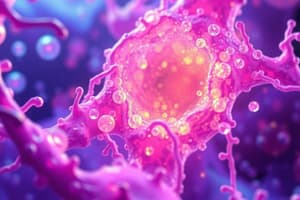Podcast
Questions and Answers
What is the main function of the Golgi apparatus?
What is the main function of the Golgi apparatus?
- Maturation and activation of proteins (correct)
- Energy production
- Formation of the cytoskeleton
- Digestion of cellular materials
Which statement accurately describes lysosomes?
Which statement accurately describes lysosomes?
- They are involved in ATP synthesis.
- They contain digestive enzymes that hydrolyze biomolecules. (correct)
- They serve as structural components of the cytoskeleton.
- They produce energy for the cell.
Which of the following best describes the structure of mitochondria?
Which of the following best describes the structure of mitochondria?
- Multiple membranes that regulate gene expression
- Permeable membrane facilitating protein synthesis
- Two membranes with smooth outer and infolded inner layers (correct)
- Single membrane with numerous infoldings
What role does the cytoskeleton play in a eukaryotic cell?
What role does the cytoskeleton play in a eukaryotic cell?
What is the primary function of mitochondria aside from energy production?
What is the primary function of mitochondria aside from energy production?
What is the primary function of the plasma membrane?
What is the primary function of the plasma membrane?
What distinguishes rough endoplasmic reticulum from smooth endoplasmic reticulum?
What distinguishes rough endoplasmic reticulum from smooth endoplasmic reticulum?
Which of the following best describes the function of ribosomes?
Which of the following best describes the function of ribosomes?
What is a characteristic feature of the Golgi apparatus?
What is a characteristic feature of the Golgi apparatus?
How do carbohydrates, lipids, proteins, and nucleic acids relate to the cell's chemical structure?
How do carbohydrates, lipids, proteins, and nucleic acids relate to the cell's chemical structure?
What role does the smooth endoplasmic reticulum (SER) play within the cell?
What role does the smooth endoplasmic reticulum (SER) play within the cell?
What are the biological levels of organization of living things starting from the simplest to the most complex?
What are the biological levels of organization of living things starting from the simplest to the most complex?
What is the primary component that represents about 70% of the cell's weight?
What is the primary component that represents about 70% of the cell's weight?
Flashcards
Cis-face of the Golgi
Cis-face of the Golgi
The side of the Golgi apparatus facing the nucleus where transport vesicles fuse.
Trans-face of the Golgi
Trans-face of the Golgi
The side of the Golgi apparatus facing the plasma membrane where secretory vesicles bud off.
Lysosomes
Lysosomes
Organelles responsible for breaking down cellular waste and worn-out components.
Mitochondria
Mitochondria
Signup and view all the flashcards
Cytoskeleton
Cytoskeleton
Signup and view all the flashcards
What is Cytology?
What is Cytology?
Signup and view all the flashcards
Types of Organisms
Types of Organisms
Signup and view all the flashcards
Levels of Biological Organization
Levels of Biological Organization
Signup and view all the flashcards
Water in the Cell
Water in the Cell
Signup and view all the flashcards
What is the Plasma Membrane?
What is the Plasma Membrane?
Signup and view all the flashcards
Plasma Membrane Barrier Function
Plasma Membrane Barrier Function
Signup and view all the flashcards
Plasma Membrane Transport Function
Plasma Membrane Transport Function
Signup and view all the flashcards
What are Ribosomes?
What are Ribosomes?
Signup and view all the flashcards
Study Notes
Cytology Lecture
- Cytology is the branch of biology and medicine that studies cell structure and function.
- Organisms can be unicellular or multicellular.
- Biological organization ranges from organelles to cells, tissues, organs, systems, and organisms. This is arranged from the simplest to the most complex.
Levels of Organization
- The biological levels of organization of living things are arranged from simplest to most complex: organelle, cells, tissues, organs, systems, and organisms.
Chemical Structure of the Cell
- Water makes up about 70% of a cell's weight and acts as a solvent for biochemical reactions.
- Organic materials in cells include carbohydrates, lipids, proteins, and nucleic acids.
- Inorganic materials include ions like Ca2+, PO43−, Na+, and Mg2+.
- Other minerals like Co2+, Cu2+, Cu3+, I−, Mn2+, and Zn2+ are also present.
Cell Components (Organelles)
- Smooth endoplasmic reticulum (SER): Network of tubules involved in lipid synthesis and detoxification.
- Rough endoplasmic reticulum (RER): Network of flattened sacs with ribosomes; involved in protein synthesis and secretion.
- Ribosomes: Particles that synthesize proteins from amino acids; can be free or bound to the RER. Ribosomes are composed of large and small subunits.
- Golgi apparatus: Flattened, disk-shaped sacs that process and package proteins. It has a cis face and a trans face.
- Lysosomes: Membrane-bound organelles containing enzymes that break down waste materials and cellular components.
- Mitochondria: "Powerhouses of the cell"; generate energy (ATP) through cellular respiration; have two membranes (inner and outer) and cristae.
- Cytoskeleton: A network of protein filaments that provides structural support and facilitates cell movement; includes microfilaments, microtubules, and intermediate filaments.
- Nucleus: The control center of the cell containing the genetic material (DNA) transmitted to offspring. It has an outer and inner membrane and nucleolus.
- Chromatin: DNA combined with proteins; is found within the nucleus.
- Nucleolus: A structure within the nucleus where ribosomes are assembled.
- Plasma membrane: A thin membrane surrounding the cell, separating the cell's contents from its environment; acts as a barrier and regulates transport. This membrane is about 0.005 μm (5nm) thick.
Studying That Suits You
Use AI to generate personalized quizzes and flashcards to suit your learning preferences.




